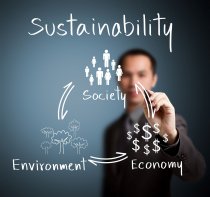
Making Sustainability a Priority in Education
In a world of globalization, a booming population and limited resources, educators serve a critical role in preparing the next generation to meet the sustainability challenges of the future. The imperatives of sustainability point not only to developing new content and course activities, but also to new ways of teaching.
So, what is sustainability? Put simply, it is the ability to maintain a certain rate or level over a period of time. More specifically, Oxford Dictionary defines it as:
1.the ability to be maintained at a certain rate or level.
2.avoidance of the depletion of natural resources in order to maintain an ecological balance.
The concept of “sustainability” offers a framework for asking enduring questions that address what we understand to be standards of living from a social, economic, and environmental perspective - What is a good and/or healthy life? How do we create a better world? While much of the concepts and activities associated with teaching sustainability are future-oriented, the relevance of those principles and practices must be understood and applied in the present.
So how should we go about teaching sustainability?
There are a plethora of resources available for educators to begin teaching sustainability at any age and level of learning. Sustainability education should be fun, engaging, and empower students to take responsibility for their actions while developing their own vision for a sustainable future.
For students, having the latest information on how climate change is impacting the environment is just one part of the learning process – Along with the issues, students must be presented with solutions. In addition to receiving real data, they should also gain tools and resources for making a difference, career opportunities, and hands-on experience with technology that can help preserve our natural resources.
Hands-on educational tools and learning guides such as those offered by AquaGrove provide students with real-world experience and empower them to take ownership and responsibility for sustainable living. In the classroom, AquaGrove enables students to utilize aquaponics to learn about the life cycle, sustainable gardening, water conservation, and food security. A few tips to help you get started with creating and teaching your own sustainability program include:
- Start Slow – Avoid information overload. The urgent messaging around global environmental crises can easily and quickly overwhelm students. Cognitive or emotional overload can cause students to feel disengaged and discouraged, which is the exact opposite of any learning program’s objective. For this reason, introduce lessons systematically, slowly and with a balance in perspectives.
- Keep it Positive - While there is plenty of “doom and gloom” when discussing challenges to environmental sustainability, it is important to balance discussions and lessons with success stories.
- Make it a Group Effort - Make sure your program includes group activities that cultivate peer engagement and support. Group discussions and collaborative projects can provide the opportunity for important dialogue that can develop group support and alleviate overload. Group activities allow for problem-solving, debate, analysis, teamwork, and reflection that are necessary for developing critical thinking and leadership skills.
- Let them Discover – You provide the data and challenge and let them provide the solutions. Often students learn and retain more about a subject by working through empirical data on their own, rather than receiving pre-digested analysis through lectures.
- Get out of the Classroom – From field trips and community events to outdoor research and expert/guest speakers, there are numerous opportunities to present information in ways that will keep students engaged and away from the desk.
As previously mentioned, there are many resources that educators may use when developing their sustainability learning program. In addition to AquaGrove’s Learning Guide, here are a few more helpful resources:
- NASA: Global Climate Change includes vital signs of the planet, the latest articles on climate change and interviews with experts on the topic.
- United States Environmental Protection Agency: Climate Change explains climate change and how humans are contributing to its creation. The site also explains what we can do to make a difference and provides a “household carbon footprint calculator“.
- Teach for America: Lessons Plans for Teaching Sustainability explores the benefits of becoming a “green school” and provides lesson plans for Grades Pre-K-2, Grades 3-5, Grades 6-8, and Grades 9-12.
- Children’s Environmental Literacy Foundation (CELF): Environmental Literacy website provides educators with tools to teach sustainability as well as information on funding and grant opportunities. For a quick visit, go directly to their resources section.
- Green Schools Initiative covers a wide range of topics and provides a list of the different green school national programs and funding opportunities.
- The Guide to Education for Sustainability offers introductory tools, background, and examples to help educators of all grade levels and subject areas use the “lens of sustainability” to strengthen lessons and community projects.
- Learning Lab offers an array of hands-on materials and resources for the K-12 classroom.
To learn about how you can begin your own sustainable learning program through aquaponics, contact AquaGrove.
